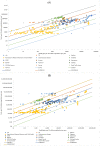Progressive Realisation of Universal Health Coverage in Low- and Middle-Income Countries: Beyond the "Best Buys"
- PMID: 33619938
- PMCID: PMC9278372
- DOI: 10.34172/ijhpm.2020.245
Progressive Realisation of Universal Health Coverage in Low- and Middle-Income Countries: Beyond the "Best Buys"
Abstract
Background: World Health Organization Choosing Interventions that are Cost-Effective (WHO CHOICE) has been a programme of the WHO for 20 years. In this latest update, we present for the first time a cross-programme analysis of the comparative cost-effectiveness of 479 intervention scenarios across 20 disease programmes and risk factors.
Methods: This analysis follows the standard WHO CHOICE approach to generalized cost-effectiveness analysis applied to two regions, Eastern sub-Saharan Africa and Southeast Asia. The scope of the analysis is all interventions included in programme specific WHO CHOICE analyses, using WHO treatment guidelines for major disease areas as the foundation. Costs are measured in 2010 international dollars, and benefits modelled beginning in 2010, or the nearest year for which validated data was available, both for a period of 100 years.
Results: Across both regions included in the analysis, interventions span multiple orders of magnitude in terms of cost-effectiveness ratios. A health benefit package optimized through a value for money lens incorporates interventions responding to all of the main drivers of disease burden. Interventions delivered through first level clinical and non-clinical services represent the majority of the high impact cost-effective interventions.
Conclusion: Cost-effectiveness is one important criterion when selecting health interventions for benefit packages to progress towards universal health coverage (UHC), but it is not the only criterion and all calculations should be adapted to the local context. To support country decision-makers, WHO CHOICE has developed a downloadable tool to support the development of data for this criterion.
Keywords: Cost-Effectiveness; Economic Evaluation; Efficiency; Universal Health Coverage.
© 2021 The Author(s); Published by Kerman University of Medical Sciences. This is an open-access article distributed under the terms of the Creative Commons Attribution License (http://creativecommons.org/licenses/by/4.0), which permits unrestricted use, distribution, and reproduction in any medium, provided the original work is properly cited.
References
-
- Lauer JA, Rajan D, Bertram MY. Priority Setting for universal health coverage: we need to focus both on substance and on process: Comment on “priority setting for universal health coverage: we need evidence-informed deliberative processes, not just more evidence on cost-effectiveness”. Int J Health Policy Manag. 2017;6(10):601–603. doi: 10.15171/ijhpm.2017.06. - DOI - PMC - PubMed
-
- World Health Organization (WHO). Together on the Road to Universal Health Coverage. Geneva: WHO; 2017.
-
- World Health Organization (WHO). Strategizing National Health in the 21st Century: A Handbook. Geneva: WHO; 2017.
MeSH terms
Grants and funding
LinkOut - more resources
Full Text Sources
Other Literature Sources



